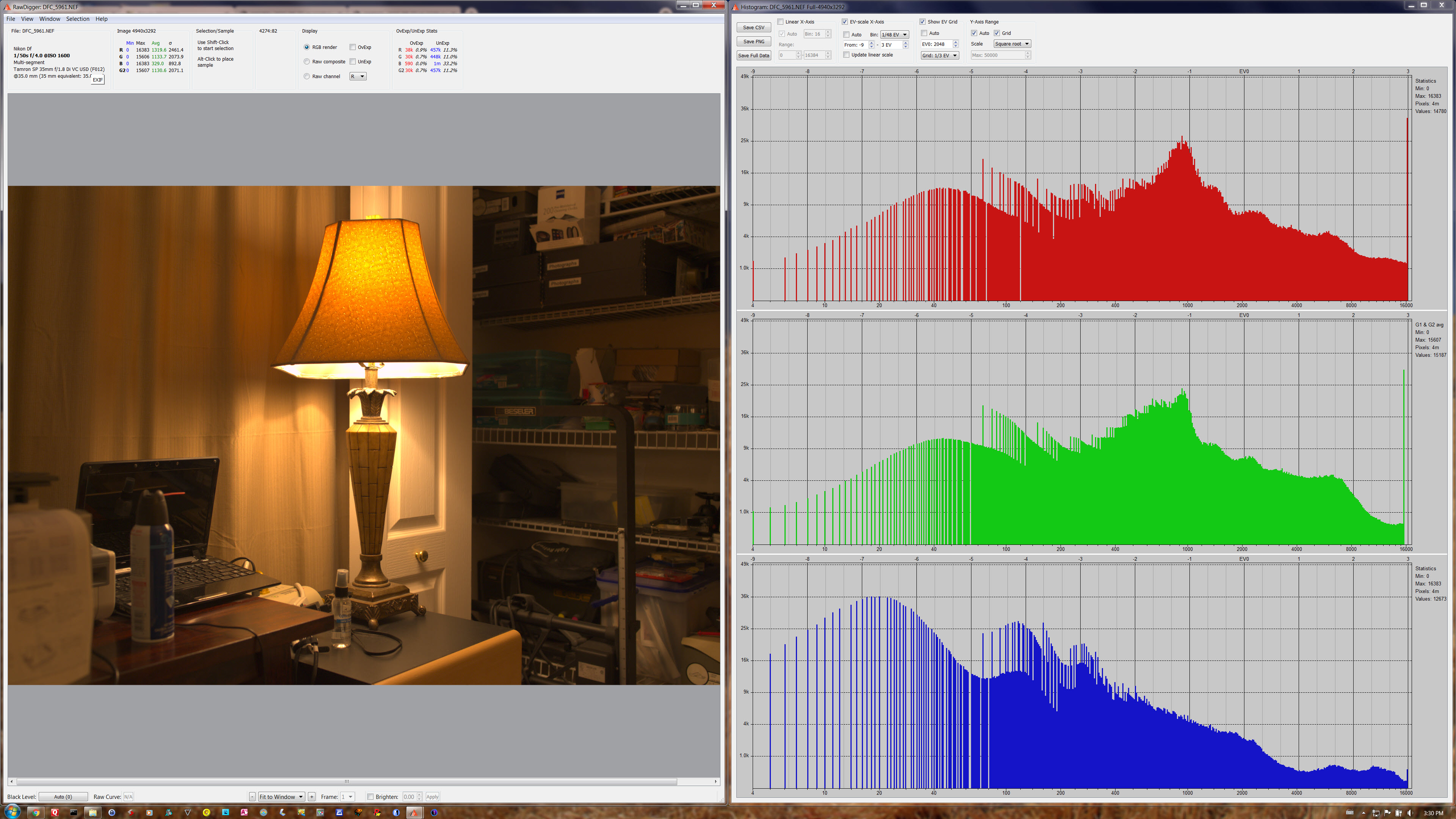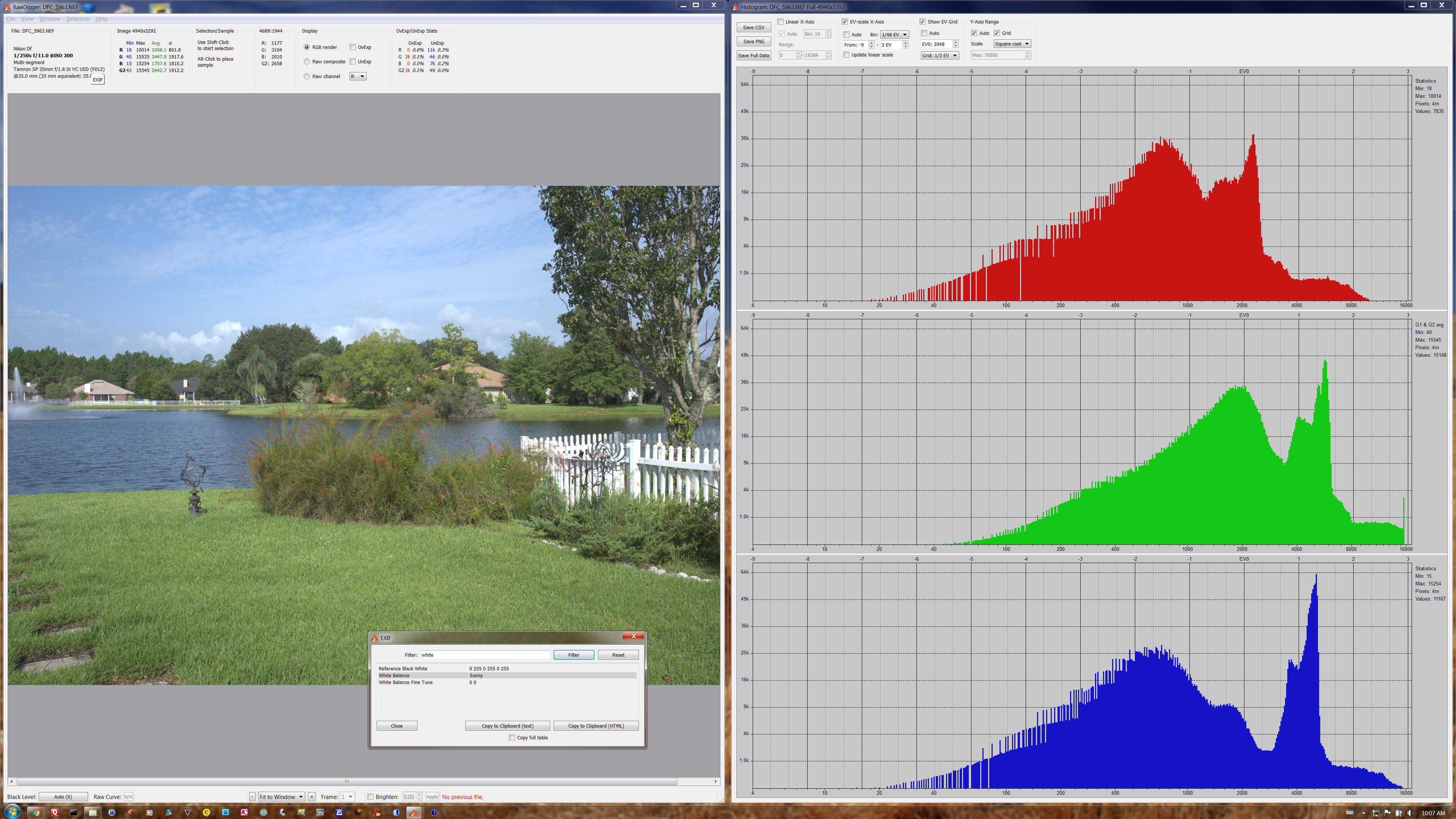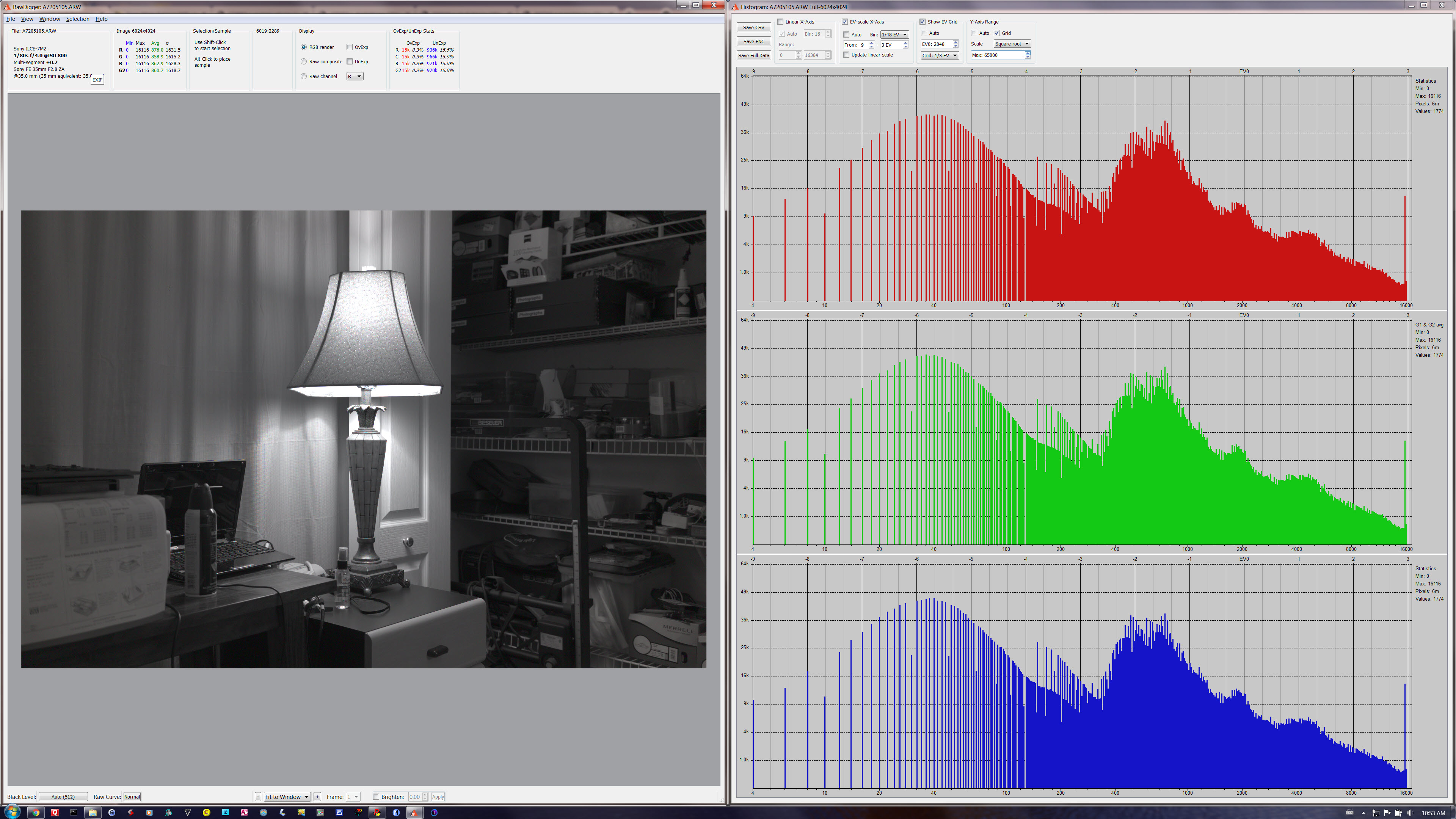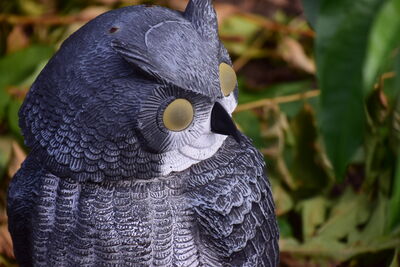Does White Balance (WB) affect the raw data?
Aug 23, 2021 17:55:59 #
Many of us already know the answer. But for anyone who needs proof, here is some evidence.
Now you can't look directly at a raw image. The raw information captured under the Bayer (or X-Trans) array needs to be converted (demosaiced) into an RGB image. Even the image displayed by RawDigger has been converted to make it visible. The only way to determine what the raw file contains is to look at the raw histogram.
The histograms you see on the back of your camera or in your raw editor are derived from the converted image, not the raw file.
In this image the camera was set to Daylight WB. The camera was at 1/50s @ f/4 ISO 1600:

RawDigger shows the converted image on the left using the WB "As Shot" - the camera's WB. The histograms on the right show how the red, green and blue raw channels recorded.
In the second image the camera was set to Incandescent WB. The camera was still at 1/50s @ f/4 ISO 1600:

Since RawDigger is still showing the image As Shot, the camera's WB made the image come out better. But notice the histograms. They are virtually identical to the first example.
But the JPEG histograms on the camera's LCD are different. They would also be different in a raw editor since those are also JPEG histograms, not raw histograms.
What's more, the number of overexposed pixels are almost exactly the same and the highlight warnings were flashing in the same places with the same intensity.
And to top things off, the recommended exposure using Matrix metering was the same for both images.
So the camera's meter and blinkies are tied directly to the raw file, not the white balanced JPEG (this may not be the case with Active D-Lighting turned on). And the raw file content is indeed independent of the WB setting.
Later I will post another example taken in broad daylight.
Now you can't look directly at a raw image. The raw information captured under the Bayer (or X-Trans) array needs to be converted (demosaiced) into an RGB image. Even the image displayed by RawDigger has been converted to make it visible. The only way to determine what the raw file contains is to look at the raw histogram.
The histograms you see on the back of your camera or in your raw editor are derived from the converted image, not the raw file.
In this image the camera was set to Daylight WB. The camera was at 1/50s @ f/4 ISO 1600:

RawDigger shows the converted image on the left using the WB "As Shot" - the camera's WB. The histograms on the right show how the red, green and blue raw channels recorded.
In the second image the camera was set to Incandescent WB. The camera was still at 1/50s @ f/4 ISO 1600:

Since RawDigger is still showing the image As Shot, the camera's WB made the image come out better. But notice the histograms. They are virtually identical to the first example.
But the JPEG histograms on the camera's LCD are different. They would also be different in a raw editor since those are also JPEG histograms, not raw histograms.
What's more, the number of overexposed pixels are almost exactly the same and the highlight warnings were flashing in the same places with the same intensity.
And to top things off, the recommended exposure using Matrix metering was the same for both images.
So the camera's meter and blinkies are tied directly to the raw file, not the white balanced JPEG (this may not be the case with Active D-Lighting turned on). And the raw file content is indeed independent of the WB setting.
Later I will post another example taken in broad daylight.
Aug 23, 2021 17:59:21 #
Aug 23, 2021 23:04:47 #
Aug 24, 2021 03:34:00 #
marquina wrote:
Beautifully explained and demonstrated! Thank you!
You are welcome.
Aug 24, 2021 03:43:36 #
Orphoto wrote:
The raw file is tied to the camera's meter/exposure, not the other way around.
They are directly correlated. There is no "other" way around.
What gets recorded in the raw file is the direct result of the exposure (aperture and shutter speed) and ISO. What the camera's meter recommends is directly related to that. So are the highlight warnings.
Changing the white balance has no influence on any of that.
Aug 24, 2021 04:28:25 #
Here is another example.
The scene is in broad daylight. I followed the Matrix metering recommendation (1/250s @ f/11 ISO 200) and that resulted in a slight overexposure of the raw file in small portions of the PVC fence. Normally I would use Sunny 16 (1/400s) or even a little darker (1/500s) which would have resulted in no highlight warnings and no blown raw channels.
The images on the left are rendered As Shot by RawDigger to show the effect of the WB setting on the image. The raw file's histograms are on the right.
Daylight (Sunny) WB:

I am skipping the Auto WB because it is almost identical. There are also several others but four more should be enough.
Cloudy WB:

Rendered slightly warmer than direct sunlight.
Shade WB:

The WB tries to make the image even warmer to offset the assumption that what is in the shade would be illuminated by the blue sky and not direct sunlight.
Incandescent (tungsten) WB:

Incandescent light is much warmer than daylight so the WB adjustment tries to make the result colder.
UniWB:

Rendered with the characteristic green bias.
The raw file is the same in each case. They are not identical because the clouds were moving and there was a slight breeze. WB did not change camera's recommended exposure and the highlight warnings appeared in the same place with the same intensity. If you look closely at the numbers there were about 6k (3K+3K) of green pixels overexposed in the raw file in each case. The Df sensor is 16MP.
For each WB setting the camera's images on the LCD were different and the JPEG histograms were different.
The scene is in broad daylight. I followed the Matrix metering recommendation (1/250s @ f/11 ISO 200) and that resulted in a slight overexposure of the raw file in small portions of the PVC fence. Normally I would use Sunny 16 (1/400s) or even a little darker (1/500s) which would have resulted in no highlight warnings and no blown raw channels.
The images on the left are rendered As Shot by RawDigger to show the effect of the WB setting on the image. The raw file's histograms are on the right.
Daylight (Sunny) WB:

I am skipping the Auto WB because it is almost identical. There are also several others but four more should be enough.
Cloudy WB:

Rendered slightly warmer than direct sunlight.
Shade WB:

The WB tries to make the image even warmer to offset the assumption that what is in the shade would be illuminated by the blue sky and not direct sunlight.
Incandescent (tungsten) WB:

Incandescent light is much warmer than daylight so the WB adjustment tries to make the result colder.
UniWB:

Rendered with the characteristic green bias.
The raw file is the same in each case. They are not identical because the clouds were moving and there was a slight breeze. WB did not change camera's recommended exposure and the highlight warnings appeared in the same place with the same intensity. If you look closely at the numbers there were about 6k (3K+3K) of green pixels overexposed in the raw file in each case. The Df sensor is 16MP.
For each WB setting the camera's images on the LCD were different and the JPEG histograms were different.
Aug 24, 2021 06:51:48 #
Very interesting but thinking about it then its probably what I would have expected with a RAW file being only what the camera records from the sensor without any other input other than the amount of light falling on to it for a fixed time at a fixed sensitivity setting (ISO)
Aug 24, 2021 09:15:23 #
Ysarex
Loc: St. Louis
selmslie wrote:
They are directly correlated. There is no "other" way around.
What gets recorded in the raw file is the direct result of the exposure (aperture and shutter speed) and ISO. What the camera's meter recommends is directly related to that. So are the highlight warnings.
Changing the white balance has no influence on any of that.
What gets recorded in the raw file is the direct result of the exposure (aperture and shutter speed) and ISO. What the camera's meter recommends is directly related to that. So are the highlight warnings.
Changing the white balance has no influence on any of that.
Maybe the case with the Nikon DF, don't know don't care, but that certainly can't be generalized to other cameras. In all of my cameras with the exposure and scene luminance held constant the highlight clipping warning responds to changes in the white balance setting.
Aug 24, 2021 09:35:02 #
JohnR wrote:
Very interesting but thinking about it then its probably what I would have expected with a RAW file being only what the camera records from the sensor without any other input other than the amount of light falling on to it for a fixed time at a fixed sensitivity setting (ISO)
It makes perfectly good sense if you think about it.
You may be surprised how many people might think they know what they are talking about and are willing to assert that it can't possibly be true. They should do their own testing.
Aug 24, 2021 09:47:37 #
Ysarex wrote:
Maybe the case with the Nikon DF, don't know don't care, but that certainly can't be generalized to other cameras. In all of my cameras with the exposure and scene luminance held constant the highlight clipping warning responds to changes in the white balance setting.
You use Fuji cameras? Why not do your own test. It's really easy.
Here is the test I just ran on the Fuji X100T at 1/15x @ f/4 ISO 800:
Daylight WB:

Tungsten WB:

The same results as the Df.
The only difference is that the X100T has a less precise leaf shutter so 1/15s looks like it's off by less than +/- 0.1 stops.
Aug 24, 2021 09:59:34 #
Ysarex
Loc: St. Louis
selmslie wrote:
You use Fuji cameras? Why not do your own test.
I've done my own tests. The highlight clipping warning on three different camera brands that I own changes with different white balance settings while holding the exposure constant. You said it doesn't and that's wrong.
Aug 24, 2021 10:12:18 #
And again with the Z7 - 1/80s @ f/4 ISO 400. This time I used Highlight Weighted Metering so there are no blown highlights.
Daylight:

Tungsten:

Same results as before.
Daylight:

Tungsten:

Same results as before.
Aug 24, 2021 10:20:40 #
Ysarex wrote:
I've done my own tests. The highlight clipping warning on three different camera brands that I own changes with different white balance settings while holding the exposure constant. You said it doesn't and that's wrong.
As you know, I am a fan of highlight clipping warnings.
If there is a difference when changing WB it's only minor. They are not a precise predictor of blown raw highlights and they don't start at the same level even within the Nikon family.
But the purpose of this thread is to show whether WB affects the raw capture. You and I (and most photographers) know it doesn't. Some skeptics need to see proof.
Aug 24, 2021 10:30:21 #
Ysarex
Loc: St. Louis
selmslie wrote:
As you know, I am a fan of highlight clipping warnings.
If there is a difference
If there is a difference
There is.
selmslie wrote:
when changing WB it's only minor.
That depends on the WB change. Clearly the highlight clipping warning on my cameras is responding to either the live feed to the EVF which typically simulates the camera JPEG output or, when chimping, the camera JPEG and not the raw file.
Aug 24, 2021 10:35:30 #
Here is the same test with the Sony A7 II which has been converted to monochrome - 1/80s @ f/4 ISO 800 with a yellow filter.
Custom WB (to produce a monochrome JPEG):

Daylight WB (there is no Bayer array so all three channels record the same levels):

I replaced the images with the vertical scale set to the same range.
The highlight warnings are the same for both images. The shadow warnings (who cares) differ slightly.
Custom WB (to produce a monochrome JPEG):

Daylight WB (there is no Bayer array so all three channels record the same levels):

I replaced the images with the vertical scale set to the same range.
The highlight warnings are the same for both images. The shadow warnings (who cares) differ slightly.
If you want to reply, then register here. Registration is free and your account is created instantly, so you can post right away.

